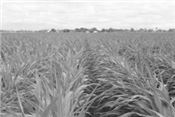|
Mid-Season Grain Sorghum Development And Management Considerations

DR. BRENT BEAN
KANSAS CITY, MO.
Agronomists often divide sorghum into three growth stages. Growth stage I begins with emergence and continues to panicle initiation, lasting approximately 35 days. During this stage, the sorghum plant can withstand significant stress from environmental conditions or pests without effecting yield because new leaves are being produced to replace damaged leaves and the growing point is below or very near the soil surface allowing it to avoid direct injury. Growth stage II (GS II) begins with panicle initiation and continues to half-bloom, also lasting approximately 35 days. Growth stage III begins with half-bloom and continues until the grain reaches maturity. This column will focus on GS II.
GS II starts with panicle initiation, which happens when the growing point of the sorghum plant changes from producing leaves to producing a panicle or head. This process typically occurs when the plant has seven to 10 visible leaf collars depending on the hybrid and environmental conditions. This transition from producing leaves (the vegetative stage) to producing a panicle and grain (the reproductive stage) is known as growing point differentiation (GPD). GPD is when the number of kernels that the plant can potentially produce is determined – the most important factor in determining final grain yield. Any stress caused by adverse weather, improper pesticide application, tillage, insects, disease, weed competition and a host of other factors can reduce panicle size and the potential number of kernels per head.

During GS II, the sorghum plant begins to rapidly grow as the plant increases to its full height and the leaves expand. To prepare for this rapid growth, as well as maximize the potential number of kernels per panicle, growers should apply any needed nitrogen before GPD. Side-dress applications of nitrogen are recommended 21 to 28 days following plant emergence. Water and nutrient use increases and peaks at the end of this stage.
Growers should check herbicide labels to determine if specific herbicides can be applied during GS II and, if so, how they should be applied. For example, if 2,4-D or dicamba is applied, drop nozzles should be used to keep the herbicides out of the whorl of the sorghum to avoid damage to the developing panicle.
Once all leaves are fully expanded and all leaf collars are visible, the sorghum plant enters the boot stage of GS II, where the panicle is wrapped in the flag leaf sheath and will be fully visible and flowering within a few days. The boot stage signals the start of a 20-day period where stress from heat, pests or lack of water can greatly reduce yield. From an irrigation scheduling standpoint, the boot stage is an ideal time to apply water. In the South, where leaf diseases such as anthracnose are common, growers also should consider fungicide application at this time.
In the southern states, midge is one of the most significant pests of sorghum and infests fields during the flowering period. Damage occurs when the midge larva feeds on the newly fertilized ovary, preventing kernel development. Although midge can often be avoided by utilizing an early planting date, growers should prepare to scout for midge during the five to seven days it takes for the panicles to complete the flowering process. More information on midge can be found at www.sorghumcheckoff.com and typing ‘midge the silent predator’ in the search bar. ∆
BRENT BEAN, Ph.D.: Sorghum Checkoff Agronomist
|
|